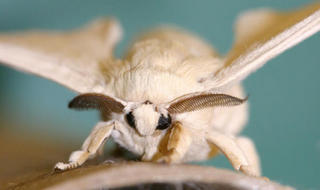Soon we learned another lesson from Nature. We had two polls for the silkworms. One was to guess in what order they start spinning. That didn't go well, because we started too late and before everybody could vote, they had already made their cocoons. The second one was to guess the gender of each worm. We had two weeks to decide since it took two weeks for the moths to come out. I'm very proud that I was the only one who got all four worms right. That is a chance of 1 in 16! I didn't really guess. I made an educated guess: since I measured their body weight almost daily, I noticed the growth difference between Worm #1 and the others. It was 1/4 smaller than the others. So I assumed it's male. And it turned to be correct. It could almost make Male #1 and its harem. The guy came out from its cocoon first, and had to wait 2 days for the next female (#4) to come out. Apparantly #1 could hardly wait to mate with #4 when the latter appeared and the mating lasted for a whole day. The second day, #1 was mating with #2, who had been waiting for a whole day for that coupling. That lasted for a whole day, too. Then it was a long, heart-wrenching wait for #3. And she just wouldn't come out. One afternoon we heard the noise she was making. But she didn't come out that day, or the day after. Then I had to go to the Cold Spring Harbor meeting. When I came back, I performed a C-section for #3. It was a sad sight. She was a mutant that wouldn't able to secret the enzyme that digests silk (这可能就是中文里所谓的“作茧自缚”了). She stayed in her cocoon and laid some unfertilized eggs. I tried to revive her, but she was too sick. Even the most ardant Male #1 couldn't coerce her into mating. I was thinking, even if they had produced any progenies, some of them would still have carried the mutant gene. What's the use to force that then? Nature is somehow cruel. This is called the fittest to survive.
So here I write a journal to commemorate my summer pets. I have safely stored their eggs at 4 degrees Celsius, all ready for another generation next Spring. Until then, we can look at some pictures of them:

The Start of a Cocoon
有句词叫“春蚕到死丝方尽”,殊不知它们还有更多更重要的事情要做呢。

这个可以叫“蛾眉”吧,很像古代仕女的眉。真的很美。
No comments:
Post a Comment